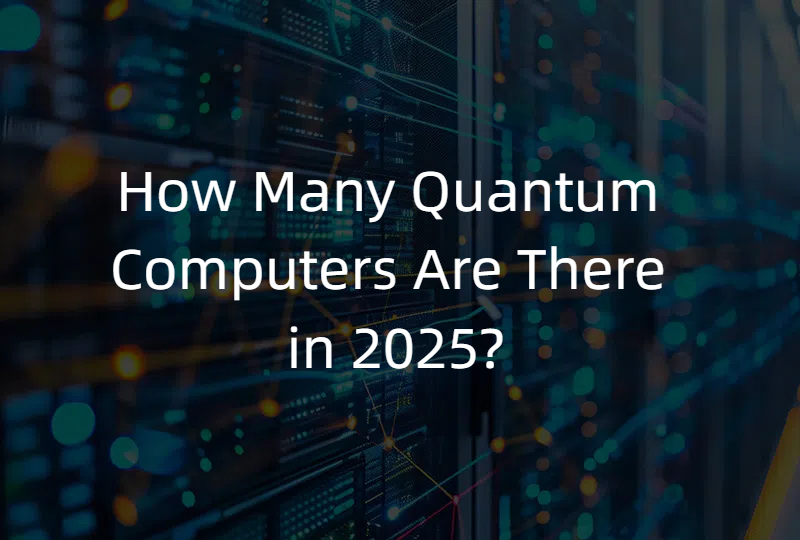From Supercomputers to Supersensors: The Quantum Technology Leap in Action
2025.08.26 · Blog Quantum Technology
Quantum technology represents a revolutionary paradigm shift that harnesses the fundamental principles of quantum mechanics to develop transformative devices and systems. Unlike classical computing that relies on bits representing either 0 or 1, quantum technology uses quantum bits (qubits) that can exist in multiple states simultaneously through quantum superposition. This unique capability, combined with quantum entanglement and interference, enables quantum systems to perform certain calculations exponentially faster than classical counterparts.
The global quantum technology market has reached a critical inflection point, with estimates showing the market valued at $1.32 billion in 2024 and projected to reach $9.65 billion by 2034, representing a robust compound annual growth rate of 22.01%. More conservative estimates place the 2025 market at $1.88 billion, growing to $4.89 billion by 2029, while broader projections suggest the collective quantum technology market could reach $99.34 billion by 2035.
Core Quantum Principles
Quantum Superposition
At the heart of quantum technology lies superposition, enabling quantum systems to exist simultaneously in multiple states. A qubit can encode a weighted combination of both 0 and 1 states, allowing quantum computers to explore vast solution spaces in parallel. This fundamental property forms the basis for quantum speedups in algorithms such as Shor's factoring and Grover's search.
Quantum Entanglement
Quantum entanglement creates inseparable correlations between multiple qubits, where measurements on one particle instantaneously affect its partners regardless of distance. This phenomenon enables quantum teleportation, underpins quantum key distribution protocols, and offers new paradigms for distributed quantum computing and sensing.
Quantum Coherence and Decoherence
Quantum coherence refers to maintaining superposition and entanglement over time, while environmental interactions induce decoherence, destroying quantum information. Achieving long coherence times demands exquisite isolation, ultralow temperatures, and sophisticated error-correction strategies. Progress in materials purity, shielding, and cryogenics has steadily extended coherence from microseconds to seconds in some platforms.
Main Quantum Technology Branches
Quantum Computing
Quantum computing represents the most prominent quantum technology application, leveraging quantum phenomena to solve computational problems beyond classical capabilities. Current implementations include:
Superconducting Qubits: Fabricated on silicon chips and cooled near absolute zero, manipulated by microwave pulses. Companies like IBM and Google have scaled processors to over 100 qubits. IBM's Condor quantum processor achieved 1,121 qubits, representing the world's largest quantum computer.
Trapped Ion Qubits: Individual ions suspended in electromagnetic traps exhibit long coherence and high-fidelity gates but face scaling challenges. IonQ demonstrated trapped-ion systems with 36 qubits showcasing all-to-all connectivity.
Photonic Qubits: Encoded in individual photons, operating at room temperature and leveraging fiber networks, though requiring efficient photon sources and detectors.
Quantum Communication
Quantum communication harnesses quantum states to transmit information with unprecedented security. Quantum Key Distribution (QKD) protocols use quantum states to generate secret keys immune to eavesdropping, as any interception disturbs the quantum states and is immediately detectable. Commercial QKD systems now operate over fiber networks spanning tens of kilometers.
Satellite-based quantum communication overcomes terrestrial limitations. China's Micius satellite and partnerships in Europe and North America have achieved intercontinental key exchange, heralding a future quantum internet.
Quantum Sensing and Metrology
Quantum sensors exploit quantum properties to measure physical quantities with unprecedented precision. Applications include:
Medical Applications: Quantum sensors enable more sensitive MRI-like scans, single-cell spectroscopy, and detection of magnetic biomarkers with subcellular resolution. Researchers have developed quantum sensors capable of detecting changes in cancer cells' magnetic properties.
Navigation and Defense: Quantum inertial sensors offer drift-free gyroscopes and accelerometers for autonomous navigation without GPS. Military applications include detecting submarines or underground structures using quantum magnetometers.
Scientific Research: Quantum sensors measure magnetic fields, temperature, and chemical signatures with atomic-scale precision. Applications range from geological surveys to environmental monitoring.
Quantum Simulation
Quantum simulators model complex quantum systems that classical computers cannot efficiently simulate. These systems are particularly valuable for chemistry and materials science, where quantum effects dominate molecular behavior. Quantum simulation applications include drug discovery, catalyst design, and understanding high-temperature superconductors.
Industry Applications and Impact
Healthcare and Drug Discovery
Quantum computing accelerates pharmaceutical research by accurately simulating molecular interactions at the quantum level. Quantum computers can model protein folding, drug-target interactions, and chemical reactions that are computationally intractable for classical systems. This capability enables faster drug discovery and development of personalized medicine.
Financial Services
Quantum optimization enhances portfolio management, risk assessment, and fraud detection. Quantum computers can process large datasets and optimize complex financial models more efficiently than classical systems. Applications include Monte Carlo simulations for derivative pricing and quantum algorithms for portfolio optimization.
Cybersecurity and Cryptography
Quantum technology presents both challenges and opportunities for cybersecurity. While quantum computers threaten current encryption methods like RSA and ECC through Shor's algorithm, they also enable quantum-safe cryptography and unbreakable quantum communication. Organizations are developing post-quantum cryptographic standards to prepare for the quantum era.
Artificial Intelligence and Machine Learning
Quantum Machine Learning (QML) combines quantum computing with AI to create more powerful predictive models. Quantum computers can handle larger datasets and explore solution spaces more efficiently than classical systems. Applications include quantum neural networks, optimization problems, and pattern recognition.
Technology Challenges and Limitations
Hardware Limitations
Current quantum systems face significant technical hurdles. Quantum decoherence remains a major challenge, as qubits are highly sensitive to environmental interference. Most quantum computers operate with relatively few high-quality qubits, limiting practical applications.
Error Rates and Noise
Quantum computers exhibit error rates orders of magnitude higher than classical systems. Current quantum devices achieve error rates around 0.1-1%, while fault-tolerant quantum computing requires rates below 0.0001%. Quantum error correction demands significant overhead, often requiring hundreds of physical qubits to create one logical qubit.
Scalability Challenges
Scaling quantum systems to thousands or millions of qubits poses significant engineering challenges. As qubit numbers increase, so does the complexity of control systems, error correction, and maintaining quantum coherence across the entire system.
Cost and Accessibility
Quantum computers require expensive infrastructure including dilution refrigerators, sophisticated control electronics, and specialized facilities. These high costs limit access to well-resourced organizations, potentially slowing innovation.
Market Trends and Investment
Market Growth
The quantum technology market shows unprecedented growth across all segments. North America remains the largest market, while Asia-Pacific, particularly China, shows rapid expansion driven by substantial government investment. Europe advances strong initiatives in quantum communication and cryptography.
Investment Landscape
Venture capital investment in quantum startups reached approximately $2 billion in 2025, with key investment areas including quantum software development, sensor development, and computing hardware. Government funding remains crucial, with major initiatives in the United States, China, Germany, and Japan.
Industry Adoption
Quantum-as-a-Service (QaaS) platforms democratize access to quantum computing. Major providers including IBM, Google, Microsoft, and emerging companies like SpinQ offer cloud-based quantum services. This model enables broader experimentation and application development across industries.
Future Roadmap and Predictions
Near-term Milestones (2025-2027)
Leading companies have established aggressive roadmaps. IBM targets demonstrating scientific quantum advantage by 2026 and fault-tolerant modules by 2027. Google aims for error-corrected quantum computers by 2029. Microsoft focuses on topological qubits with their Majorana architecture.
Medium-term Goals (2028-2030)
The industry expects practical quantum advantage in specific applications by 2030. IonQ projects systems with over 2 million physical qubits by 2030. Quantinuum targets universal fault-tolerant quantum computing by 2030.
Long-term Vision (2030+)
IBM's roadmap extends to 2033, targeting quantum computers capable of executing 1 billion gates on up to 2,000 qubits. The integration of quantum systems with classical high-performance computing and AI accelerators will create powerful hybrid computational ecosystems.
Educational and Research Institutions
Leading Universities
Several prestigious institutions are pioneering quantum research and education:
MIT: The MIT Center for Quantum Engineering leads vertically-integrated research spanning quantum computation, simulation, networks, and sensing. The MIT Quanta Group focuses on trapped-ion quantum computers and quantum signal processing.
Stanford: Stanford's Q-FARM initiative combines university and SLAC resources for quantum information science research. The Stanford program encompasses quantum photonics, quantum materials, and quantum algorithms.
University of California, Berkeley: Berkeley's Quantum Information and Computation Center leads research in quantum algorithms, quantum cryptography, and quantum hardware development.
Harvard University: The Harvard Quantum Initiative integrates physics, computer science, and engineering in quantum innovations.
Industry-Academia Partnerships
Universities are increasingly partnering with industry leaders to accelerate quantum development. Examples include IBM's collaborations with universities through the IBM Quantum Network, providing students and researchers access to quantum hardware and software tools.
Quantum Technology Companies
Major Players
IBM: A pioneer in quantum computing with their Quantum Platform providing cloud access to quantum systems and the open-source Qiskit framework.
Google Quantum AI: Developer of the breakthrough Willow quantum chip demonstrating quantum error correction below threshold.
SpinQ Technology: A comprehensive quantum computing solutions provider offering both educational and industrial quantum computers.
Emerging Companies
The quantum ecosystem includes numerous startups and specialized companies focusing on specific aspects of quantum technology, from quantum chips to quantum software and applications.
Conclusion
Quantum technology stands at the threshold of transforming multiple industries through unprecedented computational capabilities, ultra-secure communication, and precision sensing. While significant challenges remain in hardware scaling, error correction, and cost reduction, rapid progress across all quantum technology branches suggests practical applications will emerge throughout this decade.
The convergence of government investment, industry innovation, and academic breakthroughs fuels optimism that quantum technology will transition from laboratory demonstrations to practical, impactful deployments. As quantum systems achieve fault tolerance and scale, they promise to address some of humanity's most pressing challenges, from drug discovery and climate modeling to cybersecurity and artificial intelligence.
The quantum revolution is not a distant possibility but an unfolding reality, with 2025 marking a pivotal year in the commercial maturation of quantum technologies. Organizations that invest in quantum capabilities today position themselves at the forefront of tomorrow's technological landscape.
Featured Content






